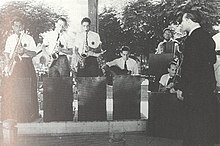Ghetto Swingers


The Ghetto Swingers were a jazz band organised in the Nazi concentration camp
The original amateur Czech band playing in the Café of the Ghetto was led by Eric Vogel and Pavel Libensky. Vogel petitioned the Kommandant on January 8, 1943. The personnel of The Ghetto Swingers would be: Dr. Brammer (piano), Dr. Kurt Bauer (percussion), Fr. Goldschmidt (guitar), Fasal (bass), Ing. Vogel (trumpet), Langer (tenor sax and clarinet), and Fr. Mautner (trombone).[3]
When the famous jazz pianist Martin Roman arrived in the camp he was asked to lead. The band appeared in a Theresienstadt cabaret review, known as the Karussell ("Carousel"). The Ghetto Swingers performed over fifty times, most frequently during June and July 1944. The cabarets were organised by Kurt Gerron, who could draw upon the best talent in the camp.[4] Both Roman and Gerron had come to Theresienstadt via the Westerbork transit camp, and qualified for entry to Theresienstadt as "artists".[5]
After the Red Cross visit to the camp, Commandant Karl Rahm instructed Gerron to make a propaganda film. Footage shows the Ghetto Swingers playing on the wooden pavilion built for Karel Ančerl's string orchestra in the town's main square.[6] After the camp closed, the members of the jazz band were sent to Auschwitz.[7] Martin Roman and guitarist Coco Schumann survived. Kurt Gerron and clarinetist Bedřich "Fritz" Weiss did not.
Schumann's 1997 biography
See also
- Swingjugend
- Women's Orchestra of Auschwitz
- Charlie and his Orchestra – German propaganda swing band
References
- ^ Ruth Elias Triumph of Hope: From Theresienstadt and Auschwitz to Israel 1999 p. 288 "Finally, we arrived home — home in the Theresienstadt ghetto. We were alive. Had they counted us? ... there was always some form of entertainment, usually light popular music performed by singers and a jazz band, the Ghetto Swingers."
- ISBN 978-1-4766-7056-0.
- ^ Joža Karas Music in Terezín 1941–1945 1985 p. 151
- ^ Michael Balfour – Theatre and war, 1933–1945: performance in extremis 2001 p. 154
- ^ Michael H. Kater Different drummers: jazz in the culture of Nazi Germany 1991 "A comfortable stay in Terezín was never guaranteed; periodically, transports were sent to Auschwitz, and they invariably consisted of the sick and elderly. p. 83 Roman and Gerron both qualified for entry into this camp as "artists".
- ^ Legacies of silence: the visual arts and the Holocaust memory p. 60 Glenn Sujo, Imperial War Museum (Great Britain) – 2001 "The renowned film producer and cabaret artist Kurt Gerron, interned in Theresienstadt, was a significant creative ... and is followed by footage of Martin Roman's jazz ensemble, the 'Ghetto Swingers', playing in the town's main square"
- ^ Dinah Shelton Encyclopedia of genocide and crimes against humanity 2005 "In the realm of jazz and popular music, Martin Roman led the Ghetto Swingers. ... Within a month most of Theresienstadt's cultural establishment, including Gerron and Haas, were deported to the gas chambers of Auschwitz. "
- ^ Coco Schumann: der Ghetto-Swinger : eine Jazzlegende erzählt Coco Schumann, Max Christian Graeff, Michaela Haas – 1997
- ^ „Svêdectvi Josefa Taussiga" (Das Zeugnis von Josef Taussig)
- ^ Joža Karas Music in Terezín, 1941–1945 p. 151 1990 "percussion; and Franta Goldschmidt was the guitarist, who unfortunately had to play on a very inferior instrument. Shortly after the establishment of the "café," on January 8, 1943. An engineer and amateur trumpet player, Erich Vogel.
